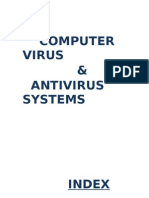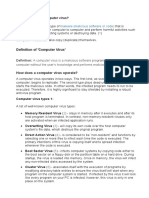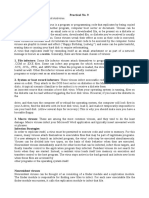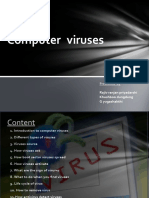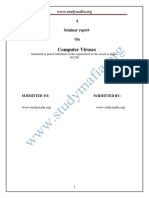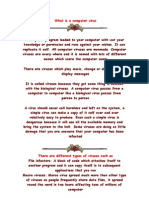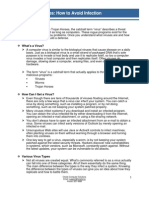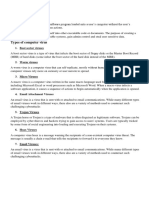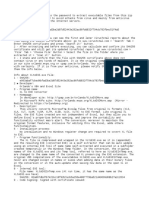Macro Viruses
Macro Viruses
Uploaded by
marecor corpuzCopyright:
Available Formats
Macro Viruses
Macro Viruses
Uploaded by
marecor corpuzOriginal Title
Copyright
Available Formats
Share this document
Did you find this document useful?
Is this content inappropriate?
Copyright:
Available Formats
Macro Viruses
Macro Viruses
Uploaded by
marecor corpuzCopyright:
Available Formats
Everything you need to know about macro viruses
What is a macro virus? A macro virus is a computer virus written in the same macro
language that is used for software applications, such as word processing programs.
Microsoft Word and Excel are two examples of applications that feature powerful macro
languages. The languages are embedded in documents. This allows them to run
automatically when the documents are open.
If a macro virus has infected these files, it has the potential to damage the document or
other computer software. When an infected file is opened, the macro virus releases a
sequence of actions that begin automatically. These actions cause damage to the
computer and its applications.
How do macro viruses spread?
Macro viruses are often spread through phishing emails containing attachments that
have been embedded with the virus. The virus will access the files in the recipient’s
address book and send an infected email to everyone on the contact list.
Because the email looks like it came from a credible source, many recipients open it.
Once an infected macro is executed, it can jump to every other document on the user’s
computer and infect them.
Macro viruses spread whenever a user opens or closes an infected document. They run
on applications and not on operating systems. The most common methods of spreading
macro viruses include:
Sharing files on a disk
Sharing files on a network
Opening a file that is an email attachment
Downloading a file via a modem and then opening the file
Downloading a file via the internet or an intranet and then opening the file
As with many other forms of viruses and malware, macro viruses can be difficult to
detect.
What do macro viruses do?
Macro viruses are programmed to perform lots of tasks on computers. For example, a
macro virus can create new files, corrupt data, move text, send files, format hard drives,
and insert pictures. One of their more common missions? Delivering destructive viruses
and malware.
An example of a macro virus
A now-classic example of a macro virus is the Melissa Virus from 1999. Opening an
email containing a document infected with the virus caused the email to send itself to
the first 50 addresses in the user’s contact list. The virus subsequently replicated at an
extraordinarily fast rate.
Application rather than operating system
Because macro viruses are based on an application rather than on an operating
system, they have the ability to infect any operating system, including those on non-
Windows computers.
What are the symptoms of a macro virus infection?
Here are a few signs that indicate your computer may have a macro virus infection:
Your computer runs slower than normal.
Your computer asks you for a password on a file that normally doesn’t require one.
Your computer saves documents as “template” files.
Your computer displays strange error messages.
How do I get rid of a macro virus?
It’s a good idea to use a reliable security software to help remove macro viruses. Most
trusted antivirus software prevents macros from downloading malware to your
computer.
Here’s what to do if you think a Word or Excel document contains a macro virus: Press
“Shift” while opening the document. This opens it in Safe Mode. It allows you to check if
there are macros present in the document. If you find anything, you can remove it
manually.
You might also like
- Test - Palo Alto Networks Accredited Systems Engineer (PSE) : Foundation Accreditation ExamDocument9 pagesTest - Palo Alto Networks Accredited Systems Engineer (PSE) : Foundation Accreditation ExamSH RumonNo ratings yet
- Introduction To Computer VirusesDocument31 pagesIntroduction To Computer Virusesaafy92% (12)
- What Is A Computer Security RiskDocument10 pagesWhat Is A Computer Security Riskhantu malamNo ratings yet
- Malacious SoftwareDocument54 pagesMalacious SoftwareNarender KumarNo ratings yet
- Virus and Its TypesDocument7 pagesVirus and Its TypesrajNo ratings yet
- Anti Virus Best Practices PDFDocument8 pagesAnti Virus Best Practices PDFkprasad_mlNo ratings yet
- Introduction To Computer Software and HardwareDocument11 pagesIntroduction To Computer Software and Hardwareحسين ناهضNo ratings yet
- Eden Solomon Computing Science AssignmentDocument7 pagesEden Solomon Computing Science AssignmentMariamawit WorknehNo ratings yet
- Definition of 'Computer Virus'Document20 pagesDefinition of 'Computer Virus'BDlive. LandNo ratings yet
- Erbil Polytechnic University Erbil Technical College Civil Engineering Department 1 Stage / Group (A)Document6 pagesErbil Polytechnic University Erbil Technical College Civil Engineering Department 1 Stage / Group (A)Blnd HawdianyNo ratings yet
- Code Floppy Disk CD DVD USB Drive: Some Viruses Can Crash Your PC. Check Out The Types of VirusesDocument6 pagesCode Floppy Disk CD DVD USB Drive: Some Viruses Can Crash Your PC. Check Out The Types of VirusesNaveen K. SurayNo ratings yet
- Computer Virus and Its TypesDocument7 pagesComputer Virus and Its TypesM Salman Ryan100% (1)
- My Presentation TopicDocument16 pagesMy Presentation TopicUsha KtNo ratings yet
- IT Notes COMPUTER VIRUSESDocument2 pagesIT Notes COMPUTER VIRUSESDiliannis HopkinsonNo ratings yet
- By: Abd Rashid Bin HJ Shafie Penyelaras Bestari SMK Gunung Rapat, IpohDocument4 pagesBy: Abd Rashid Bin HJ Shafie Penyelaras Bestari SMK Gunung Rapat, IpohEiza AliasNo ratings yet
- Differences Between Worms and VirusesDocument9 pagesDifferences Between Worms and VirusesChe Andrea Arandia AbarraNo ratings yet
- Report Computervirus 190303140330Document16 pagesReport Computervirus 190303140330auadm1311No ratings yet
- Introduction To Viruses PDFDocument31 pagesIntroduction To Viruses PDFjatin100% (1)
- ICT LM Week 2Document37 pagesICT LM Week 2akioNo ratings yet
- Computer VirusesDocument26 pagesComputer VirusesMahe KotaNo ratings yet
- The History of Computer VirusDocument5 pagesThe History of Computer VirusDrRohitKumarMDHomNo ratings yet
- Practical No. 9Document2 pagesPractical No. 9Rahul PatelNo ratings yet
- Computer Virus TypesDocument7 pagesComputer Virus TypesmohanakalaiselviNo ratings yet
- Computer VirusDocument5 pagesComputer Virussatudas149No ratings yet
- Computer Virus and Penetration Technique: Mayej - S@yahoo - Co.inDocument5 pagesComputer Virus and Penetration Technique: Mayej - S@yahoo - Co.inJournal of Computer ApplicationsNo ratings yet
- Computer Viruses: Presented byDocument31 pagesComputer Viruses: Presented byRajiv PriyadarshiNo ratings yet
- CSE Computer Virus and AntivirusDocument33 pagesCSE Computer Virus and AntivirusYASHASWINI RNo ratings yet
- Computer VirusDocument28 pagesComputer VirusPiyuSh JainNo ratings yet
- VirusDocument8 pagesVirusRavula KartheekNo ratings yet
- Computer Viruses Types of Viruses Use of Antivirus - WPS OfficeDocument6 pagesComputer Viruses Types of Viruses Use of Antivirus - WPS OfficeMai Cres Brazil CrescencioNo ratings yet
- Computer VirusDocument7 pagesComputer Viruscabella_pasaporteNo ratings yet
- VirusDocument5 pagesVirusarunNo ratings yet
- Iy5512 - 4Document4 pagesIy5512 - 4Francis 'Oluwaseyi' JohnsonNo ratings yet
- CV NotesDocument3 pagesCV Notesvinod000No ratings yet
- Virus 1Document28 pagesVirus 1AtharvaNo ratings yet
- Getting Ill Sucks.Document3 pagesGetting Ill Sucks.Subhajit KunduNo ratings yet
- What Is A Computer VirusDocument14 pagesWhat Is A Computer VirusJohn YohansNo ratings yet
- Malware: DR - Talal AlkharobiDocument39 pagesMalware: DR - Talal Alkharobimwaseem2011No ratings yet
- Data CompressionDocument17 pagesData CompressionmuhamedNo ratings yet
- Project On VirusDocument30 pagesProject On VirusRitu WaliaNo ratings yet
- Trojan Horse: Computer Viruses Typically Attach To An Executable Host FileDocument3 pagesTrojan Horse: Computer Viruses Typically Attach To An Executable Host FileReena CorreaNo ratings yet
- VirusDocument4 pagesVirusboualem.ini2002No ratings yet
- ComputerSecurity Virus and ThreatsDocument17 pagesComputerSecurity Virus and Threatskripaaanja321No ratings yet
- VirusDocument6 pagesVirusAtharvaNo ratings yet
- Data Security From Malicious Attack Computer VirusDocument10 pagesData Security From Malicious Attack Computer VirusVMads3850No ratings yet
- Introduction To Computer: Semester: BS 5 Environmental SciencesDocument22 pagesIntroduction To Computer: Semester: BS 5 Environmental Sciencesrida faizNo ratings yet
- Computer VirusDocument11 pagesComputer VirusSudha MauryaNo ratings yet
- Ethical - Hacking-1 (Islamic University of Science and Technology Pulwama)Document37 pagesEthical - Hacking-1 (Islamic University of Science and Technology Pulwama)cse 20 42Syed TawqeerNo ratings yet
- 08 Computer VirusDocument27 pages08 Computer VirusziafmcsNo ratings yet
- Computer Viruses: How To Avoid InfectionDocument6 pagesComputer Viruses: How To Avoid Infection22shimmer22No ratings yet
- Topic: Types of Computers VirusDocument10 pagesTopic: Types of Computers VirusOmar LeivaNo ratings yet
- Virus and Related ThreatsDocument28 pagesVirus and Related ThreatsNatarajan Kumaran100% (1)
- Computer VirusesDocument3 pagesComputer Virusesdrin filesNo ratings yet
- Types of VirsesDocument1 pageTypes of VirsesZuhaib SultanNo ratings yet
- An Introduction To Computer VirusesDocument22 pagesAn Introduction To Computer VirusesharithrissurNo ratings yet
- 2ND Term Data Proc. E-NoteDocument30 pages2ND Term Data Proc. E-NoteEro ChuksNo ratings yet
- Computer Viruses Exposed: No More Infections: Beat Malware, Adware, And Spyware Now!From EverandComputer Viruses Exposed: No More Infections: Beat Malware, Adware, And Spyware Now!No ratings yet
- Meeting 5 Malicious SoftwareDocument12 pagesMeeting 5 Malicious SoftwareAdi Agus PrayogaNo ratings yet
- Norton Antivirus 2003Document3 pagesNorton Antivirus 2003siba_sagarNo ratings yet
- Preventive Measures For Computer VirusesDocument19 pagesPreventive Measures For Computer VirusesJellyn CamañaNo ratings yet
- 3BDD017314 D en Security Update ServiceDocument2 pages3BDD017314 D en Security Update ServiceMartin MavrovNo ratings yet
- Polymorphic CodeDocument1 pagePolymorphic CodeJashNo ratings yet
- Virus ToolsDocument10 pagesVirus ToolsHeetNo ratings yet
- MBST Clean ResultsDocument53 pagesMBST Clean ResultsIrwinUruchiNo ratings yet
- Comp7 - Quarter 3 Module 2-3Document5 pagesComp7 - Quarter 3 Module 2-3John Mark PrestozaNo ratings yet
- Assignsubmission - File - Assignment 2 DocumentDocument4 pagesAssignsubmission - File - Assignment 2 Documentflamingmonkey46No ratings yet
- Typo NOTES CHAPTER 7 Computer VirusDocument13 pagesTypo NOTES CHAPTER 7 Computer VirusShashank MishraNo ratings yet
- How To InstallDocument2 pagesHow To InstallTechnical SupportNo ratings yet
- Anglais Sujet 1Document4 pagesAnglais Sujet 1castlen023No ratings yet
- Managing Information Systems: Seventh Canadian EditionDocument37 pagesManaging Information Systems: Seventh Canadian EditionJayson KingNo ratings yet
- Cyber Security Seminar ReportDocument19 pagesCyber Security Seminar ReportManik SharmaNo ratings yet
- Step To Install FortiClient V1.2Document10 pagesStep To Install FortiClient V1.2Khairul IrfanNo ratings yet
- Project 3Document4 pagesProject 3Huynhgiahuy HuỳnhNo ratings yet
- Managed Antivirus: A Feature Available With Solarwinds RMMDocument1 pageManaged Antivirus: A Feature Available With Solarwinds RMMrjrjghjrghNo ratings yet
- Licencias y Usuarios para ESET NOD32 Antivirus Diciembre 2020-2021Document2 pagesLicencias y Usuarios para ESET NOD32 Antivirus Diciembre 2020-2021Felipe Arturo Zamora RuedaNo ratings yet
- KOMALA Annual Work Report in 2023Document7 pagesKOMALA Annual Work Report in 2023kamidikamalakarNo ratings yet
- Types of VirsesDocument1 pageTypes of VirsesZuhaib SultanNo ratings yet
- Zip Password Is '123abc'. ReadmeDocument2 pagesZip Password Is '123abc'. Readmeوهيبه بكرNo ratings yet
- 2024 Malware Obfuscation and EvasionDocument154 pages2024 Malware Obfuscation and Evasionv4reskNo ratings yet
- Computer WorksheetDocument6 pagesComputer WorksheetAisha AnwarNo ratings yet
- Ecse Team 15 CybersecurityDocument13 pagesEcse Team 15 CybersecurityTheerdala VigneshNo ratings yet
- Data-Performance For TallyDocument2 pagesData-Performance For Tallymr_brijNo ratings yet
- Cyber Security 7Document2 pagesCyber Security 7Nash Nicole LorenzoNo ratings yet
- Antivirus Artifacts IiiDocument44 pagesAntivirus Artifacts IiiJustinNo ratings yet
- History of VirusDocument15 pagesHistory of VirusKeziah Cheluj GamengNo ratings yet
- What Is The Dif-WPS OfficeDocument3 pagesWhat Is The Dif-WPS OfficeMeena AliNo ratings yet

